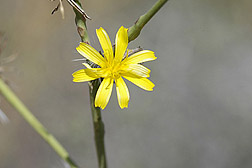Genotype Exploration Is Key
to Controlling Rush Skeletonweed
|
|
There is a bit of mystery surrounding the rush skeletonweed growing in the Pacific Northwest. Scientists don’t really know how it got there.
“We know it started in Spokane, Washington, and spread from there,” says John Gaskin, a botanist and research leader at the ARS Pest Management Research Unit in Sidney, Montana. “But we don’t know exactly where it came from.”
Herbarium records indicate rush skeletonweed, Chondrilla juncea, first invaded the eastern United States in the 1870s. But its appearance in the western United States came much later—in 1938.
Today, the plant’s population is mainly restricted to the Pacific Northwest, making it difficult to determine whether its invasion there originated in the eastern United States or overseas. Rush skeletonweed now occupies about 2.5 million hectares of land in the northwest United States. In Idaho alone, the infested area increased from 20 hectares in the 1960s to 1.4 million hectares in the mid-1980s.
Rush skeletonweed is a frustrating problem for farmers, ranchers, and scientists. It is a threat to irrigated lands, dryland cropping areas, and rangelands. It affects the cattle industry by displacing beneficial forage species, and its tall, wiry, latex-producing stems hinder the operation of crop harvest machinery. The weed is also starting to invade natural forests, outcompeting native plants for valuable nutrients.
Rush skeletonweed’s extensive, deep root system makes it difficult to control. The vertical taproot in established plants can penetrate more than 10 feet deep. Lateral roots branch off the main taproot and form satellite plants. Tillage can drag root fragments to noninfested areas where they can take root and form new colonies.
The current biocontrol agents for this weed—a gall midge, a gall mite, and a rust fungus—were introduced in the 1970s and have become widely established, but they don’t work on all biotypes of the species. The rapid spread of rush skeletonweed in the Pacific Northwest during the past two decades indicates that it is not being effectively controlled.
Seeing this predicament, Gaskin and his colleagues from the University of Idaho and the USDA Forest Service’s Rocky Mountain Research Station began researching rush skeletonweed’s genealogy in hopes of finding a solution. The research team received 721 samples of the weed’s flowers from county weed agencies in the northwest United States and Canada.
Using a laboratory procedure called “amplified fragment length polymorphism,” Gaskin found there are seven genotypes of rush skeletonweed in all of North America, five of which reside in the Pacific Northwest.
“Now that we know where specific rush skeletonweed genotypes are located in the United States,” says Gaskin, “it can help us determine what control methods to use. The information will help with selecting and testing new biocontrol agents and determining where to implement them, as not all genotypes are in all regions.”
Gaskin and his colleagues are currently trying to pinpoint exactly where in Eurasia, the plant’s place of origin, the North American genotypes came from. Their goal is to find a highly host-specific biocontrol agent to control the rush skeletonweed population in the Pacific Northwest.—By Stephanie Yao, Agricultural Research Service Information Staff.
This research is part of Crop Protection and Quarantine, an ARS national program (#304) described on the World Wide Web at www.nps.ars.usda.gov.
John Gaskin is in the USDA-ARS Pest Management Research Unit, 1500 North Central Ave., Sidney, MT 59270-4202; phone (406) 433-9444, fax (406) 433-5038.
"Genotype Exploration Is Key to Controlling Rush Skeletonweed" was published in the July 2009 issue of Agricultural Research magazine.








